“The Neutral Patent Evaluation Process is not the only avenue for potential resolution. But it is a helpful and cost-effective tool for patent owners and accused sellers alike to resolve their disputes with the help of Amazon.”
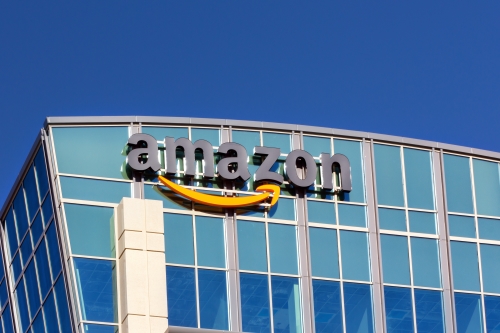 In part one of this series, I outlined the preliminary steps I took on behalf of my client “Bill” to initiate Amazon’s Neutral Patent Evaluation Process. In part two, I will describe the substantive procedure of the evaluation process and its successful resolution.
In part one of this series, I outlined the preliminary steps I took on behalf of my client “Bill” to initiate Amazon’s Neutral Patent Evaluation Process. In part two, I will describe the substantive procedure of the evaluation process and its successful resolution.
At the end of part one, my client—patent owner Bill—had just completed the initial steps to start the process:
- Bill requested to participate in Amazon’s Neutral Patent Evaluation Process, submitted a statement identifying the 31 accused infringing products by their Amazon Standard Identification Number (ASIN) and explained how the products infringed his patent.
- Amazon then initiated its Neutral Patent Evaluation Process by sending Bill and the 31 accused infringing sellers a neutral patent evaluation agreement.
- Bill executed and returned the evaluation agreement to Amazon.
- Bill was waiting to see which of the 31 accused sellers would agree to participate in the evaluation process by Amazon’s deadline.

According to Amazon’s rules, an accused seller has 21 days in which to decide whether to sign Amazon’s agreement and participate in the Neutral Patent Evaluation Process. If the seller signs the agreement and agrees to the evaluation, its listings will remain active until the conclusion of the neutral evaluation process. However, if the seller does not agree to participate in the evaluation process, Amazon will remove the listings of the seller’s accused products from Amazon’s marketplace.
Under Amazon’s rules, Bill had the option of resolving his claims against individual sellers who contacted him directly within the 21-day period. During this period, some sellers contacted Bill and apologized for infringing his patent rights and promised not to sell the infringing products. In one case, Bill agreed to allow the infringing seller to sell its limited inventory of infringing products by a certain date. In another case, Bill entered into a licensing agreement with the infringing seller whereby Bill receives a royalty on each infringing product sold.
Out of 31 accused sellers, three sellers ultimately signed Amazon’s agreement and agreed to participate in the Neutral Patent Evaluation Process. At the outset of the process, Amazon selected a neutral third-party patent lawyer to serve as the evaluator. Then, Amazon sent instructions to Bill and the sellers on how to pay the $4,000 deposit to the evaluator.
Once each party paid their respective deposits, the evaluator contacted the parties to inform them about the process:
After receiving these instructions from the evaluator, I prepared and sent to the evaluator Bill’s written submission explaining how the accused products infringed Bill’s patent. I described the invention taught in claim one of Bill’s patent and provided a comprehensive analysis about how each accused product infringed that claim. I also included a claim chart and detailed pictures for each accused product showing how each relevant feature of the accused products met each element of claim one of the patent.
Shortly after submitting Bill’s written submission, one of the sellers voluntarily withdrew from the evaluation process. As a result, Amazon took down that seller’s accused product listing.
Two weeks later, the two remaining sellers submitted their respective written responses. Under the evaluation procedure, a seller may only make three arguments: (1) the accused product does not infringe the asserted patent; (2) a court of competent jurisdiction, the U.S. Patent Office or U.S. International Trade Commission has found that the asserted patent claim is invalid or unenforceable; and (3) the accused seller has credible evidence that the accused products (or physically identical products) were on sale one year or more before the asserted patent’s earliest effective filing date.
Each seller made different arguments as to why their products did not infringe Bill’s patent. One seller—“Seller X”—argued that its product did not infringe because a “physically identical” product to Bill’s patented invention was on sale one year or more before the patent’s priority date. In support of its argument, Seller X provided almost 50 pages of exhibits. The other seller—“Seller Y”—argued that its product did not infringe Bill’s patent because its product did not have all elements of claim one of Bill’s patent.
Bill and I had seven days to reply to these arguments. In Bill’s reply to Seller X, I argued that the claimed “physically identical” products actually taught away from claim one of Bill’s patent. Further, I pointed out that some of the “physically identical” products were on sale less than a year before the patent’s earliest effective date. Finally, I noted that other exhibits offered by Seller X were not independently verifiable because they did not show the relevant features of the product at issue.
In Bill’s reply to Seller Y, I highlighted the fact that Seller Y admitted that the photographs included in Bill’s initial submission were of its accused product. I then explained how these photographs clearly demonstrated that the accused product contained each and every element from claim one of Bill’s patent.
Fourteen days later, the evaluator provided the parties the evaluator’s detailed written decision form. The evaluator found that Bill was likely to be able to prove that the accused products sold by Sellers X and Y infringed claim one of Bill’s patent. The evaluator also determined that Seller X did not establish invalidity of claim one based on earlier sales because Seller X did not provide any credible evidence that there were “physically identical” products for sale one year or more before the earliest effective filing date of Bill’s patent.
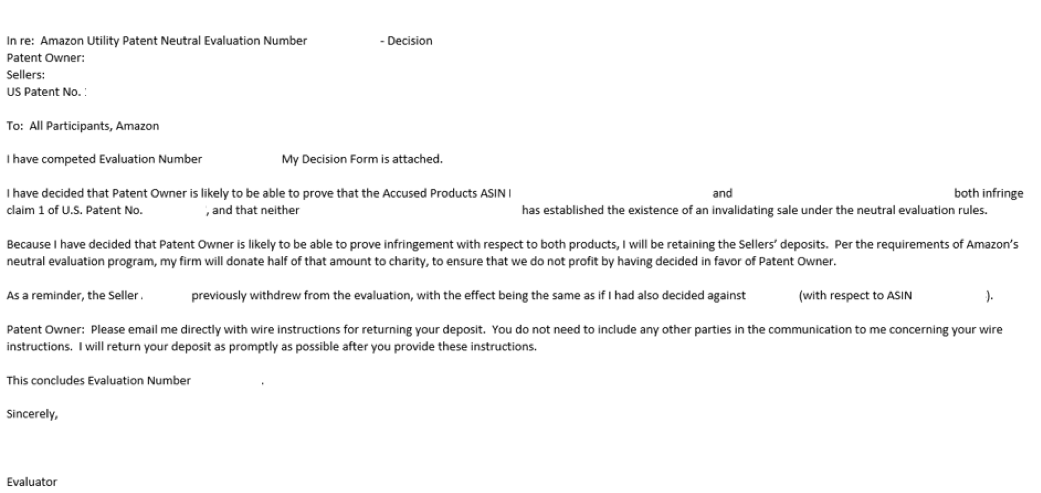 Afterwards, the evaluator returned Bill’s $4,000 deposit, and Amazon removed the sellers’ accused product listings from its marketplace. Overall, Bill and I were extremely pleased with the speed and efficiency of the evaluation process and delighted with the outcome. Moving forward, Bill requested that my firm monitor Amazon for additional infringing products. Because we have already participated in the Neutral Patent Evaluation Process and obtained a favorable outcome, Bill and I will simply report any future infringers to Amazon without having to initiate the evaluation process for a second time.
Afterwards, the evaluator returned Bill’s $4,000 deposit, and Amazon removed the sellers’ accused product listings from its marketplace. Overall, Bill and I were extremely pleased with the speed and efficiency of the evaluation process and delighted with the outcome. Moving forward, Bill requested that my firm monitor Amazon for additional infringing products. Because we have already participated in the Neutral Patent Evaluation Process and obtained a favorable outcome, Bill and I will simply report any future infringers to Amazon without having to initiate the evaluation process for a second time.
Image Source: Deposit Photos
Author: wolterke
Image ID: 40325209

![[IPWatchdog Logo]](https://ipwatchdog.com/wp-content/themes/IPWatchdog%20-%202023/assets/images/temp/logo-small@2x.png)

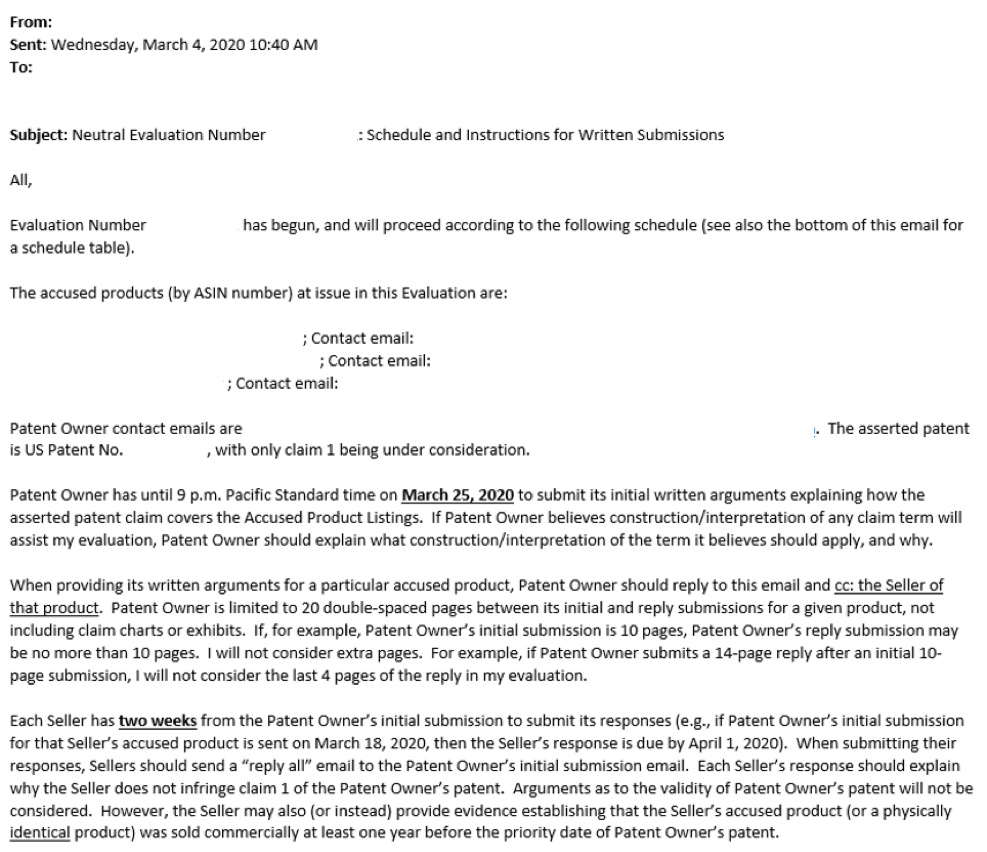
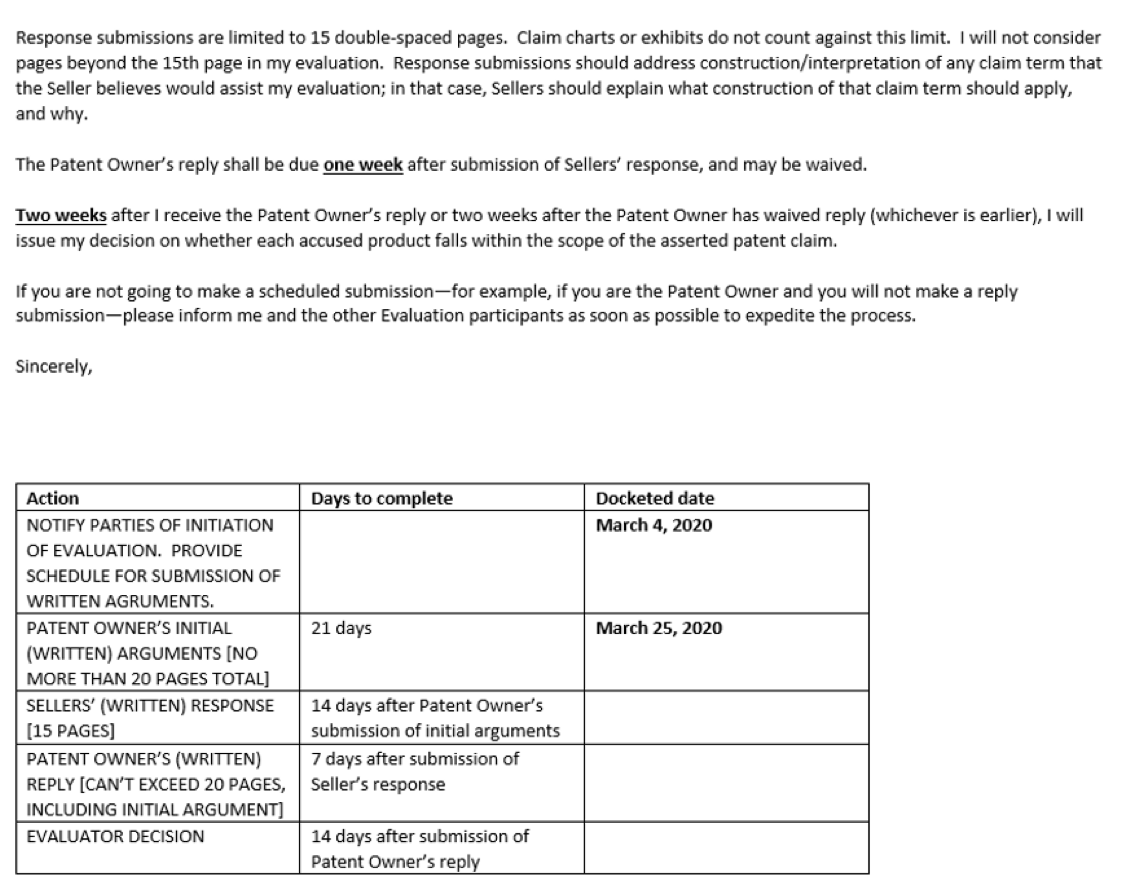
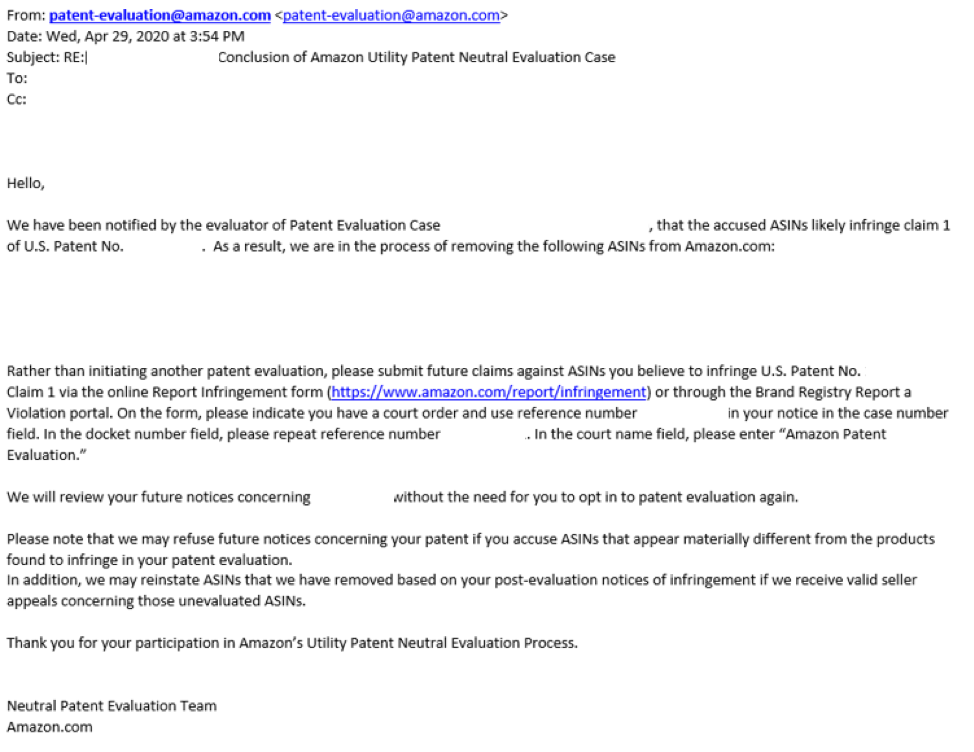
![[Advertisement]](https://ipwatchdog.com/wp-content/uploads/2024/04/Patent-Litigation-Masters-2024-sidebar-early-bird-ends-Apr-21-last-chance-700x500-1.jpg)

![[Advertisement]](https://ipwatchdog.com/wp-content/uploads/2021/12/WEBINAR-336-x-280-px.png)
![[Advertisement]](https://ipwatchdog.com/wp-content/uploads/2021/12/2021-Patent-Practice-on-Demand-recorded-Feb-2021-336-x-280.jpg)
![[Advertisement]](https://ipwatchdog.com/wp-content/uploads/2021/12/Ad-4-The-Invent-Patent-System™.png)






Join the Discussion
11 comments so far.
Anon
June 24, 2020 06:14 pmI’m curious – did Amazon make you pay the $4,000 fee for each seller that wanted to participate in the NPE process? Or was it a flat $4,000 regardless of how many sellers participated?
anonymous
June 4, 2020 12:12 amMeanwhile, Amazon kept all its profits from past infringing sales, and all profits from the $119/yr Amazon Prime subscription it charged buyers. Infringers kept their profits from past infringing sales.
So the value of the process is THE INJUNCTION. It is the right to exclude that has value to the patent owner (and to Amazon, so long as it can skim its own commission).
Congress, are you and the courts listening yet? It is the right to exclude that has value. It is an exclusive market for the patent owner that provides value. If only you’d realize the same principle is spelled out in the Constitution – the same right you are to act “by securing” to “inventors”.
Josh Malone
June 3, 2020 04:31 pmI advise not agreeing to sell off allowance or granting of licenses. It creates evidence against irreparable harm which impairs your ability to obtain an injunction should you have to seek relief from a real court.
Josh Malone
June 3, 2020 04:25 pmSeller X seemed to raise an invalidity argument which is not one of the 3 options you listed. Why didn’t you object?
Option 2 requires an order from another court, so it does not apply.
Option 3 requires the SELLER to have offered the accused product prior to the effective filing date. You indicate that the 50 exhibits were of 3rd party products, which do not fall under this defense option
Anon
June 3, 2020 03:18 pmAlso, since any future entity that you DO identify will have its own rights (and pseudo due process), how is it that your last statement of “Because we have already participated in the Neutral Patent Evaluation Process and obtained a favorable outcome, Bill and I will simply report any future infringers to Amazon without having to initiate the evaluation process for a second time. is true?
(These comments do NOT address any earlier concerns that have been raised – notably comment 8 in the linked part one story, although there are other issues in the ensuing back and forth of later comments by myself and others).
Anon
June 3, 2020 03:17 pmDo you realize just how easy it is to play the ‘whack a mole’ game and have you in a perpetual chase mode?
Does Bill really win with this approach?
Anon
June 3, 2020 03:16 pmAs to “a seller may only make three arguments,” this is an interesting argument against the process from the other side. Why only these three arguments? Especially number 3 – how would this be known without some investigation – these seem unduly limited.
But perhaps the biggest snag I have with this part two of the series is “Moving forward, Bill requested that my firm monitor Amazon for additional infringing products.“
Anon
June 3, 2020 03:16 pmThe devil is in the details, as they say, and even just looking at the PTAB, supposed ‘neutrality’ may NOT be actually present.
Anon
June 3, 2020 03:15 pmstill tripping the ‘page moved’ response…
In paragraphs then.
I am curious as to how the following step was actually undertaken:
At the outset of the process, Amazon selected a neutral third-party patent lawyer to serve as the evaluator.
Anon
June 3, 2020 03:13 pmtrying again…
Anon
June 3, 2020 10:03 amA comment that I have is seeing a reply of “The page has moved.”